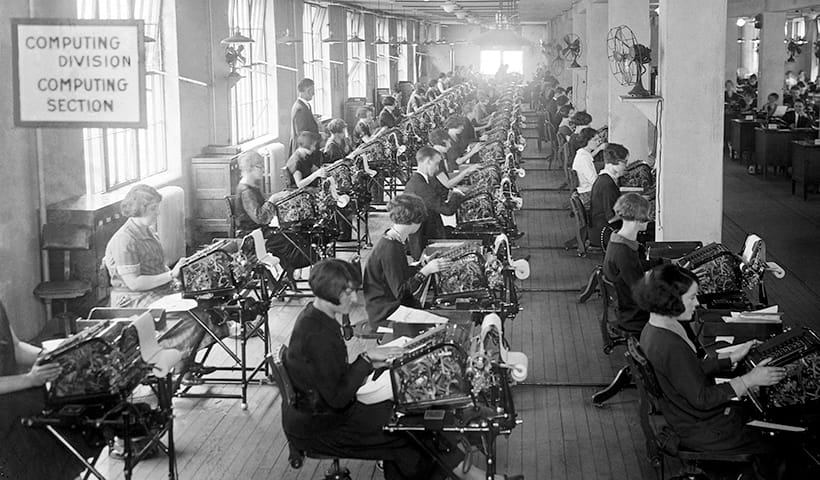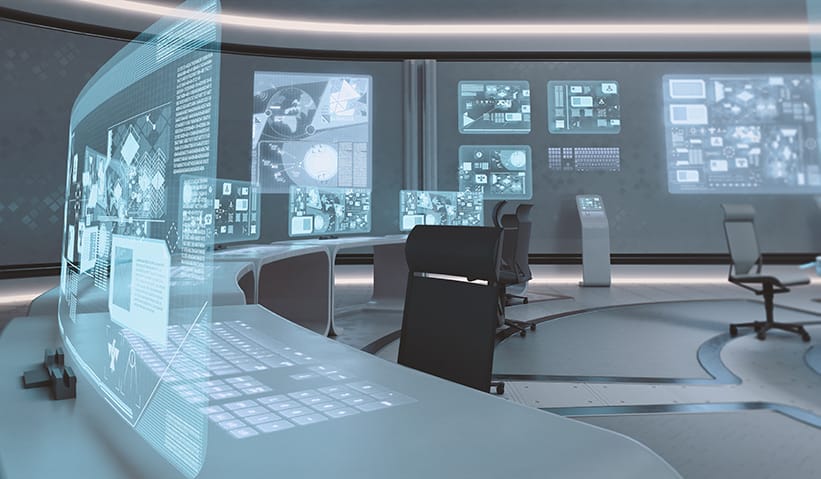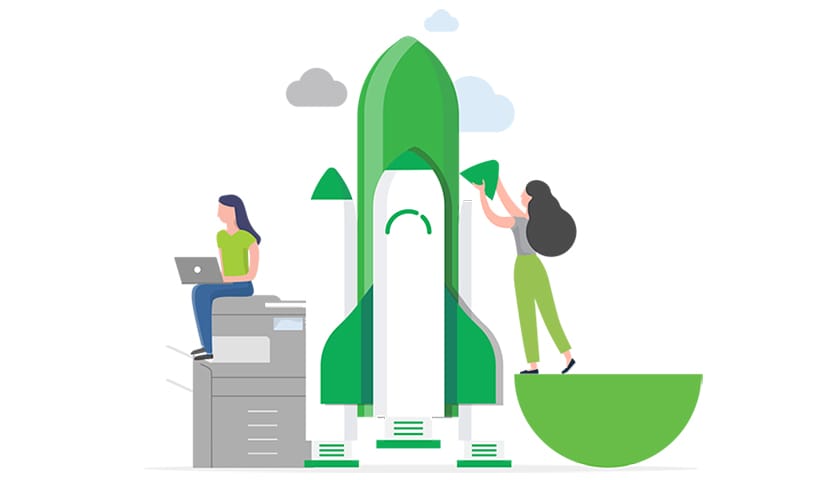Science fiction has made a lot of promises that reality has only half fulfilled.
The Jetsons promised flying cars, we got self-driving cars . 2001: A Space Odyssey promised AI capable of interstellar travel, we got smart homes . Back to the Future promised hoverboards, we got a kind of hoverboard (after Tony Hawk broke our hearts in a Funny or Die prank ).
Perhaps the lowest bar to clear was the “paperless office”.
Yet it’s now 2020 and we’re still printing.
The office: an origin story

Before “the paperless office”, there was just “the office” (not the UK or USA sitcoms).
The concept of an office existed as an idea long before it became standard practice. The origins span back to around medieval times, specifically when circa 1500s monks hand-transcribed religious texts in work stations provided by the church.
The office picked up steam during the seventeenth century and eventually became more commonplace throughout the nineteenth and twentieth centuries, amidst the industrial revolution.
Rise of the machines

The office developed as technology advanced.
The 1800s birthed Samuel Morse’s telegraph, Alexander Graham Bell’s telephone and Thomas Edison’s phonograph (though I’m not sure when the ubiquitous office headphones became a thing).
Come the 1900s a new age of telecommunications allowed for an expanded workforce and streamlined access to information.
Then computers happened. Well, not like the next day.
Visions of the modern computer popped up in the early 1800s courtesy of Charles Babbage . Then computer science continued to progress throughout the 1930s and 40s, thanks to Alan Turing’s Bombe and Tommy Flowers’s Colossus , with both men operating out of Bletchley Park during WWII.
Hop, skip, and a jump to 1951 when the LEO I became the first computer used for commercial business applications. Later, in 1964, IBM unveiled an early automated word processor , dawning the age of automation in the workplace.
Thus began “the robots are coming to take our jobs” paranoia.
Office of the Future

Visions of tomorrow’s workplace started before the proliferation of computers, while the office was still developing.
The concept of a futuristic workplace spans back to 1945 when an article in Life magazine prophesied sentient “man-made machines” in the office.
Three decades on, Business Week coined the term “Office of the Future” with predictions of electronic work terminals and filing cabinets - and they were pretty on the money.
“Paperless office” was uttered for the first time three years later by Micronet Inc. in 1978.
But we didn’t get there.
Worldwide paper-use doubled between 1980 and 2000 and continued to grow.
Welcome to the world of tomorrow

Laptops, tablets, smartphones, cloud computing, Google glasses (well maybe not Google glasses) - we’re living in the future workplace that yesteryear predicted.
But we’re still not paperless .
Why not?
It’s a long answer (and this blog is already so nice and brief) but let’s tick off a checklist of explanations…
3 reasons why we’re not fully paperless
- History Between the 1500s and 1900s, as the office was developing, there was one staple: paper (well, office gossip too). Documentation was hardcopy before and during the wonderful world of computing. Backcataloguing all that paper is a gargantuan feat for archivists. Transitioning from paper to paperless costs time and money.
- Culture While you’re trying to reduce office printing, a friend or colleague buries their eyes in a paperback instead of an e-reader. “I just prefer the tactile feel of turning the pages,” they say. This is just one of many analog traditionalist movements counterattacking the techno revolution. It begs some questions: do we need to hang onto paper for posterity? do some people just refuse to evolve? is technophobia anti-green?
- Convenience We frankly just made it too dang effortless and convenient to print. Mobile devices and the affordability of printers and MFDs meant anyone and everyone could print whatever and whenever they wanted.
The inconvenient truth is we like using paper. It’s embedded in our DNA and the office’s DNA.
Combine that with the above factors and the idea of a fully paperless office feels like it may have been doomed from the oft.
With technology rapidly advancing, each year seems to position the paperless office closer and closer to being snuffed out forever…
A new hope

Digitisation has reduced printing, but not eliminated it.
But instead of completely eradicating paper, the “paper-light office” or “lesspaper office”, as we call it, has a groundswell.
In fact, it’s a pragmatic step towards “paperless”.
As many email signatures remind you, occupational mindfulness and accountability have transformed how, what, when, and why we print.
Many businesses have discovered that while paperless is the dream, the reality is different.
But continuing to print doesn’t mean that you can’t do so in a green way.
Lesspaper strikes back

We don’t want to eliminate the use of paper, but we do want to minimise waste.
Whether or not paperless is inevitable or a pipe dream, a promise half-kept is better than no follow-through at all. As one YouTuber comments on actual footage of Tony Hawk on a real hoverboard, “It’s only half an inch off the ground but atleast [sic] we’re making progress.”
If you can’t go paperless, you can go lesspaper.
PaperCut is on the frontlines of the paperless vs lesspaper wars and helps you reduce paper wastage via an arsenal of sustainable printing practices .




